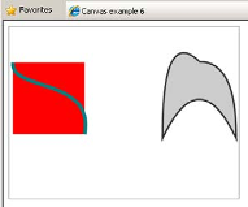HTML and CSS Reference
In-Depth Information
(VML)
.
VML
is a predecessor of
SVG
, and you've already seen that
SVG
and
<canvas>
can do a lot of similar things. The
explorercanvas
library implements
<canvas>
in
IE8
and earlier using
VML
. Activating
explorercanvas
is as simple as including a
<script>
element in the head
of your
HTML
document:
<head>
<!--[if IE lte 8]><script src="excanvas.js"></script><![endif]-->
</head>
If you add that to any of the examples
you've seen in this chapter, you
should see them rendering in
IE8
as
the screenshot at right.
SVG in XML vs. SVG in HTML
I mentioned earlier that
SVG
support
isn't as clear-cut as
<canvas>
support.
This isn't just because the
SVG
speci-
fication is more complex but also
because there are more ways to use
SVG
from within a web page. This
is largely because
SVG
was originally envisioned as one of a family of
XML
-based languages that would be used for web content.
In nearly all the major browsers, it has long been possible to embed
SVG
content in the
XML
version of
HTML/XHTML
. Unfortunately,
there has been one major obstacle to this happening.
Fully compliant XHTML should be delivered from the server as XML
content. The server tells the browser the content type of the file
in the header of the HTTP response. Unfortunately, if you try to
send an XML web page to a version of Internet Explorer earlier
than 9, it refuses to parse the page. Because deploying SVG in XHTML
requires breaking IE, few people have considered it practical.
Embedding SVG as an image
SVG
can be used in the
<img>
element in the same way as any other
image format:
<img src="svg-2.svg">





